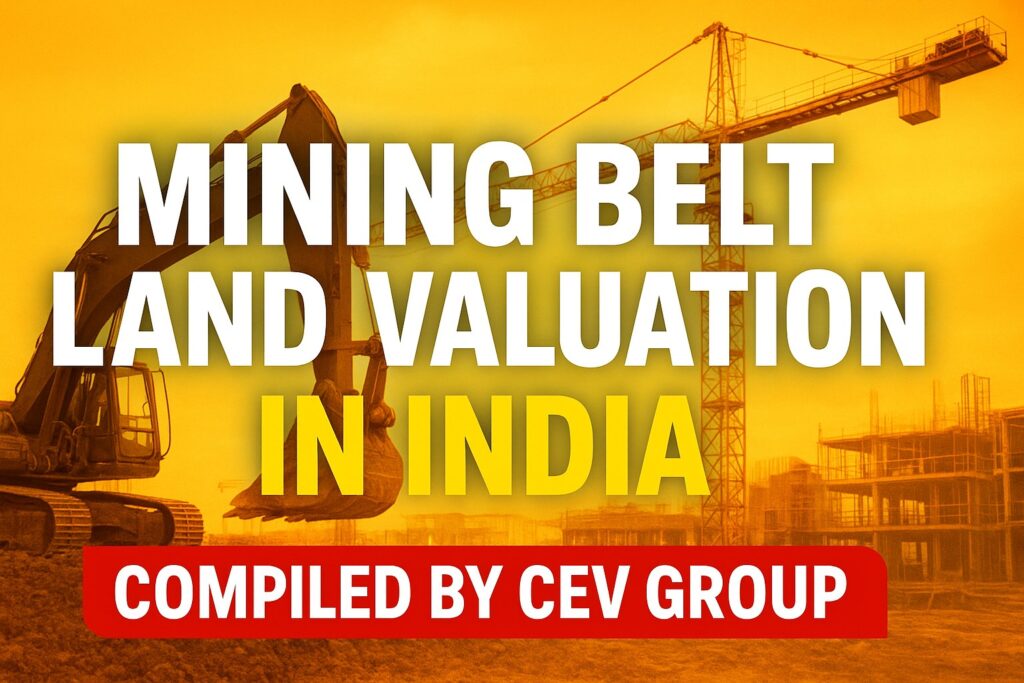
VALUATION OF LANDS IN INDIA’S MINING BELT
A TECHNICAL AND ECONOMIC PERSPECTIVE


For Professionals in Engineering, Valuation, and Land Administration
Quick recap
The meeting focused on the valuation of mining lands in India’s mining belt, with CEV introducing an exclusive video and article discussing the complex nature of assessing mining properties. The discussion covered various valuation methodologies, including the discounted cash flow method, and emphasized key factors influencing mining belt valuation such as mineral reserves, grade, and quality. The conversation ended with an overview of specialized valuation considerations, environmental and regulatory factors, and the role of the Council of Engineers and Valuers in standardizing and educating professionals on complex valuation methods.
Summary
Mining Land Valuation Video Introduction
CEV introduces an exclusive video on the valuation of lands in India’s mining belt, inviting viewers to like, comment, and subscribe to the official YouTube channel of CEV Group. The video and an accompanying article are available on CVNews.in, where viewers can access related news and articles on education and empowerment. CEV explains how to navigate the website to find the video and related articles, emphasizing the importance of the topic for professional updates.
Mining Land Valuation in India
The article on mining land valuation in India, compiled by Avinash Kulkarni, highlights the complex nature of assessing mining lands due to the convergence of geology, engineering, environmental science, regulatory policy, and market economics. The Council of Engineers and Valuers (CEV) has taken a significant step by addressing this subject through detailed analysis, emphasizing evaluation methodologies, influencing factors, and the regulatory framework governing mining properties in India. Mining lands differ from typical real estate properties as their value is driven by the nature, extent, and economic feasibility of mineral deposits beneath the surface, making understanding their valuation crucial for registered valuers and professionals associated with the IBBA valuation ecosystem.
Mining Project Evaluation Methodologies
CEV discussed the evaluation methodologies for mining projects, which vary based on the project’s phase: exploration, under development, or fully operational. Key determinants include mineral content, market demand, extraction feasibility, and environmental compliance obligations. The discounted cash flow method is the most widely accepted approach for valuing operational or advanced development mining projects, making it the preferred method out of the three approaches discussed.
Mining Land Valuation Methods
CEV explained the process of valuing mining land using the discounted cash flow (DCF) method, which involves projecting future cash flows from mineral extraction and discounting them to present value. The steps include estimating mineral reserves, determining production capacity and mine lifespan, calculating capital and operating expenses, forecasting revenues based on commodity prices, and computing the net present value of expected cash flows. CEV also mentioned the cost approach as an alternative method, which focuses on the replacement or reproduction cost of mining infrastructure and surface assets.
Mining Valuation: Cost Approach Challenges
The discussion focused on valuation approaches in mining, particularly the cost approach which is rarely used for valuing mineralized land due to the limited relationship between construction costs and inherent mineral value. The conversation highlighted that key factors influencing mining belt valuation include mineral reserves, grade, and quality, with these factors being primary determinants of value.
Mining Land Value Determinants
The discussion focused on key factors influencing land value in mining contexts, including mineral grade, tonnage, and quality of reserves, which are determined through geological exploration data and feasibility studies. The location’s proximity to transportation networks and infrastructure, as well as the regulatory environment governed by the Mines and Minerals Development and Regulation Act of 1957 and subsequent amendments, were highlighted as crucial considerations for valuation.
Mining Property Valuation Insights
The meeting focused on various aspects of mining property valuation, including lease allocation, compliance norms, and the Right to Fair Compensation and Transparency in Land Acquisition, Rehabilitation, and Resettlement Act 2013. Environmental impact assessments, sustainability commitments, and social license to operate were highlighted as integral to valuation. The discussion also covered specialized valuation considerations for different development stages of mining properties, economic and market trends influencing profitability, and the data required by valuers for accurate assessments. The conversation ended with an overview of mining economics, the importance of mineral deposit valuations for lending purposes, and the role of the Council of Engineers and Valuers in standardizing and educating professionals on complex valuation methods.
The valuation of land in India’s mining belts represents one of the most intricate and multidisciplinary aspects of asset assessment. This complexity arises due to the convergence of geology, engineering, environmental science, regulatory policy, and market economics.
The Council of Engineers and Valuers (CEV) has taken a major step forward by addressing this subject through a detailed analysis, emphasizing the valuation methodologies, influencing factors, and regulatory framework governing mining properties in India.
Mining lands differ significantly from typical real estate properties. Their value is driven not just by location or market demand, but by the nature, extent, and economic feasibility of the mineral deposits beneath the surface.
As India continues to promote sustainable resource utilization, understanding the valuation of mining land has become a crucial skill for registered valuers and professionals associated with the IBBI valuation ecosystem.
Understanding the Core of Mining Land Valuation
Mining belt land valuation in India is influenced by multiple factors including geological potential, developmental stage, regulatory approvals, and macroeconomic conditions. The valuation methodology varies according to whether the mine is in the exploration phase, under development, or fully operational. Key determinants include the mineral content, market demand, extraction feasibility, and environmental compliance obligations such as rehabilitation and resettlement provisions.
Methodologies for Mining Land Valuation
1. Income Approach (Discounted Cash Flow Method)
The Discounted Cash Flow (DCF) method is the most widely accepted approach for valuing operational or advanced development mining projects. It involves projecting future cash flows derived from mineral extraction and discounting them to present value using an appropriate discount rate. The steps typically include:
A) Estimating the quantity and grade of mineral reserves.
B) Determining production capacity and mine lifespan.
C) Calculating capital and operating expenditures.
D) Forecasting future revenues based on projected commodity prices.
E) Computing the Net Present Value (NPV) of the expected cash flows.
This method captures the economic value of a mining asset by reflecting its real-world financial performance and investment risks.
2. Cost Approach
The Cost Approach focuses on the replacement or reproduction cost of mining-related infrastructure and surface assets such as plants, machinery, or processing units. However, it is rarely used for valuing the mineralized land itself, as the construction cost often bears little relationship to the inherent value of the underlying mineral deposits.
Factors Influencing Valuation in Mining Belts
1. Mineral Reserves
The grade, tonnage, and quality of mineral reserves are primary determinants of land value. Geological exploration data and feasibility studies are vital in establishing economically recoverable reserves.
2. Location and Infrastructure
Proximity to transportation networks, ports, and industrial zones directly influences operational costs and market access, thereby affecting the valuation outcome.
3. Regulatory Environment
The Mines and Minerals (Development and Regulation) Act, 1957 and subsequent amendments, along with state-specific mining policies, govern lease allocation, auction procedures, and compliance norms. These significantly affect the marketability and valuation of mining properties.
4. Land Acquisition and Compensation
The Right to Fair Compensation and Transparency in Land Acquisition, Rehabilitation and Resettlement (RFCTLARR) Act, 2013, ensures that landowners and affected families receive equitable compensation and rehabilitation benefits. Valuers must assess compensation liabilities and resettlement costs when determining overall project feasibility.
5. Environmental and Social Considerations
Environmental Impact Assessments (EIA), sustainability commitments, and social license to operate are integral to valuation. Compliance costs for mitigation, waste management, and post-mining land restoration are essential deductions in the valuation process.
6. Economic and Market Trends
Commodity prices, demand fluctuations, and macroeconomic conditions influence the profitability of mining projects. For instance, global demand for critical minerals like lithium and rare earth elements can dramatically shift valuation dynamics.
Specialized Valuation Considerations
A. Based on Development Stage
- Exploration Properties: Speculative valuation based on exploration expenditures or comparable transactions.
- Development Properties: Valued using DCF methods post-feasibility study when reserves are proven.
- Production Properties: Operational mines are typically valued on actual cash flows using the income approach.
B. Royalties and Taxes
Royalties and dead rent payable to the government form part of the operational cost and influence DCF projections. The Indian Bureau of Mines (IBM) publishes reference prices for minerals, providing a benchmark for valuation adjustments.
Mining Economics: Core Determinants
Mining economics revolves around productivity, cost efficiency, and ore quality. Factors include ore depth, grade, accessibility, labour costs, waste removal ratio, equipment efficiency, and transport distances. The higher the operational efficiency and ore quality, the greater the value realization.
For underground operations, additional variables such as rock strength, water inflow, and geometry of ore bodies significantly affect costs and profitability.
Data Required by Valuers
Valuers rely on a comprehensive set of data to ensure accuracy and regulatory compliance. Essential documentation includes:
- Market value of comparable land.
- Title deeds and ownership records.
- Geological and mineral reports (including chemical analysis).
- Borehole data and maps from Geological Survey of India (GSI).
- Mining license and environmental clearances.
- Expert opinions from certified geologists.
- Pollution Control Board approvals.
- Production and saleability assessments of minerals.
Valuation of Mineral Deposits
Valuation involves estimating the total volume, density, and recoverable percentage of minerals. The valuer must determine:
- Extent and depth of mineral deposits.
- Bulk density and core recovery ratio.
- Total recoverable tonnage.
- Adopted cost per unit of mineral.
- Overall market value and profitability projection.
Profitability Assessment and Market Potential
Tentative profitability of mining land can be estimated by evaluating:
- Average selling price per metric tonne.
- Total mining and transportation expenditure.
- Gross and net profit per tonne.
- Estimated life of mine and total recoverable reserves.
This projection is vital for investors and financial institutions assessing the economic viability of mining ventures.
Valuation for Lending Purposes
If Offered as Collateral Security:
When mining land is offered as collateral, mineral deposit valuation is typically ignored. Post-extraction, the land value reverts to its base agricultural or barren land value.
If Offered as Primary Security:
When used as primary security for financing mine development, the valuation of mineral deposits becomes crucial. The estimated value of the mineral, plant, and profitability projections are considered to determine loan eligibility and risk exposure.
Mining belt land valuation in India represents a fusion of science, economics, and law. The Council of Engineers and Valuers (CEV) continues to play a pivotal role in standardizing and educating professionals on such complex valuation methodologies. By integrating techniques such as DCF, aligning with regulatory norms, and recognizing socio-environmental obligations, valuers can deliver accurate and responsible assessments that balance commercial interests with sustainable development.
Published by: Council of Engineers and Valuers (CEV)





